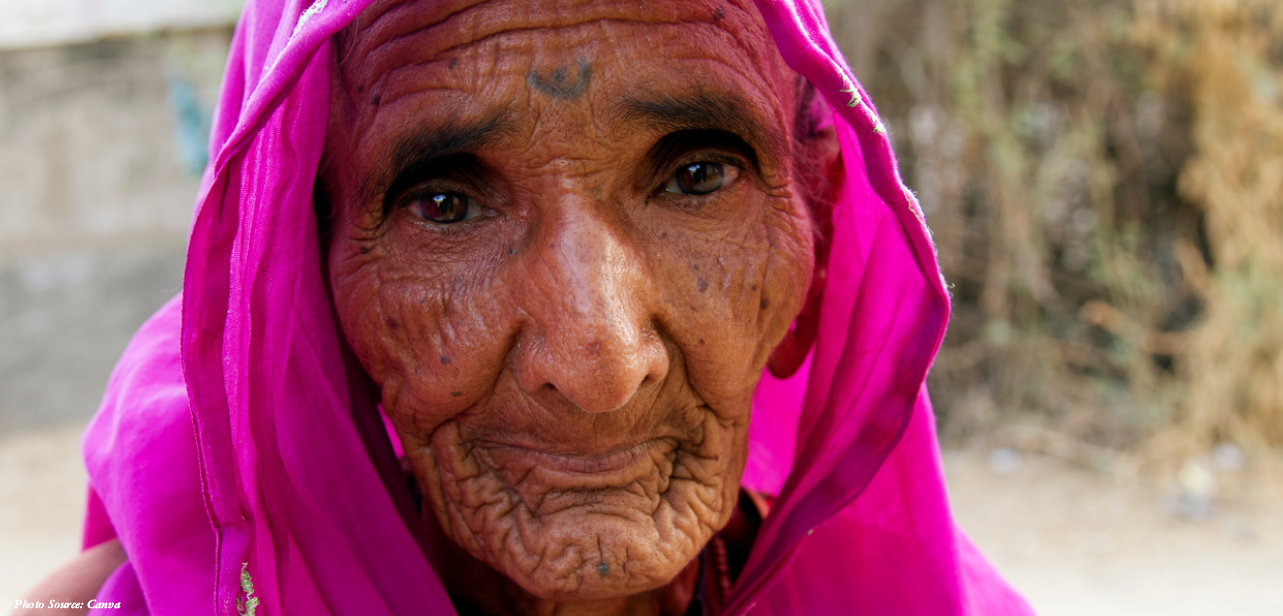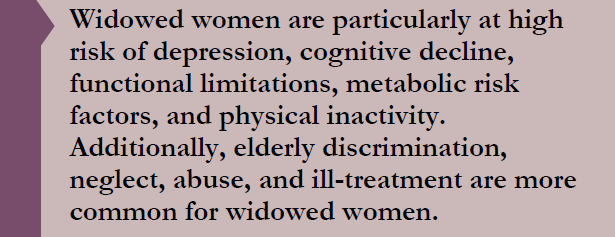

India, currently the most populous country in the world with 1.43 billion people, is experiencing a rapid ageing transition. The elderly population aged 60+ years numbering 149 million in 2022 (or 10% of the total population) is projected to rise to 347 million (or 20%) in 2050 (United Nations, 2022). Women in India are now living longer than men and, therefore, elderly women outnumber elderly men. The Longitudinal Ageing Study in India (LASI, 2017-18), is India’s first nationwide survey to provide a formidable range of national and statewide database for designing policies and programmes for the older population in the broad domains of social, psychological, health and economic well-being (Arokiasamy et al., 2022). This commentary highlights significant gender disparities in the health and well-being of India’s older population and, overall, how India’s older women are worse off than older men (Figure 1)
 The data in the domain of cardiovascular health reveals older women (39%) experienced higher levels of cardiovascular disease (CVD), which includes hypertension, heart disease and stroke, than older men (31%). A higher proportion of older women (22%) than older men (16%) reported bone/joint disease. Older women also reported higher prevalence of anaemia and cancer than older men. The data on symptoms, injuries, endemic diseases, and women health issues revealed older women reported a higher prevalence of these health conditions including angina pectoris, sleep problems, pain, and endemic diseases than men.
The data in the domain of cardiovascular health reveals older women (39%) experienced higher levels of cardiovascular disease (CVD), which includes hypertension, heart disease and stroke, than older men (31%). A higher proportion of older women (22%) than older men (16%) reported bone/joint disease. Older women also reported higher prevalence of anaemia and cancer than older men. The data on symptoms, injuries, endemic diseases, and women health issues revealed older women reported a higher prevalence of these health conditions including angina pectoris, sleep problems, pain, and endemic diseases than men.
 In terms of metabolic health, the prevalence of overweight/obesity is more common among older women (26%)) and high-risk waist circumference is more widely prevalent among older adult women (39% for women, 9% for men). Thyroid disorder, one of the metabolic diseases, is more prevalent among older women. The proportionately higher burden of these metabolic health risk conditions among older women raises their vulnerability to the higher burden of non-communicable diseases, disability, and overall poor health.
In terms of metabolic health, the prevalence of overweight/obesity is more common among older women (26%)) and high-risk waist circumference is more widely prevalent among older adult women (39% for women, 9% for men). Thyroid disorder, one of the metabolic diseases, is more prevalent among older women. The proportionately higher burden of these metabolic health risk conditions among older women raises their vulnerability to the higher burden of non-communicable diseases, disability, and overall poor health.
Gender differences in mental health components particularly cognitive ability and depression (based on diagnostic symptoms) are more pronounced among older women. India has a higher share of widowed women due to both significant marriage age gaps and the longer life expectancy of older women. Widowed women are particularly at high risk of depression, cognitive decline, functional limitations, metabolic risk factors, and physical inactivity. Additionally, elderly discrimination, neglect, abuse, and ill-treatment are more common for widowed women.
A number of elderly women-specific acute health conditions are widely prevalent. Urinary continence, a debilitating condition more commonly affecting older women (11.4%), presents a significant health problem with many older women experiencing more acute and rarer types of urinary incontinence. This condition increases two to three-fold among those with kidney and bone disease, multimorbidity and other acute chronic conditions. Also, women aged 45–59 reported significant reproductive health problems including menstrual, menopausal, or gynaecological health concerns. Around half of women aged 45-59 years from Mizoram (52%) and one-third of women in Himachal Pradesh (32%) reported having such reproductive health problems.
More older women than older men reported a much higher prevalence of low vision (40%), hearing impairment, and oral health problems (53%) compromising their overall quality of life and well-being. Consequently, more elderly women than men, and more of those with no schooling, currently not working and widowed, reported poor self-rated health. Mobility is one of the important components of functional health and a significant component of self-care and the ability to access essential public services. 81 per cent of elderly women reported some type of mobility restrictions – walking, climbing stairs, stretching arms, etc. Older women also reported a higher rate of work-limiting health conditions (32%). In terms of the functional health measure 2+IADL (Instrumental Activity of Daily Living), almost half of older women (57%) compared to about a quarter of older men (38%) reported 2+IADL limitations.
Additionally, the subnational patterns of gender differences in the health and well-being of the older population suggest the complex regional dynamics of gender inequalities and ageing. For example, the geographic patterns of gender-based differences in education add significantly to the observed differences in both physical and mental health conditions between older women and men. This pattern is consistent with the existing literature on geographic and regional patterns of gender-based inequalities in socioeconomic and health indicators across the states of India (Arokiasamy and Goli, 2012; Dandona et al., 2017). Lower levels of early-life human capital investments in nutrition and education among women compared with men are associated with a female disadvantage in late-life health and well-being (Angrisani et al., 2020).
These and other substantial evidence of older women’s disadvantage in health and well-being indicators suggest the need for gender-based provisioning in elderly health and social care policy. India’s demographic ageing is rapidly going to increase the number of older adults and the consequent increase in the prevalence of age-associated health risk factors and the noncommunicable disease burden, including dementia, needs effective multifactorial health intervention strategies. Many of the serious health problems experienced by women are viewed merely as a consequence of ageing, and consequently under-reported and neglected for timely diagnosis despite their long-term physical and mental health consequences. The adverse impact of health problems on elderly women’s lives and well-being calls for integrated healthcare and social support policies targeting older women.
References
Angrisani, M., U. Jain, & J. Lee (2020). Sex differences in cognitive health among older adults in India. Journal of the American Geriatrics Society, 68, S20-S28.
Arokiasamy, P., & S. Goli (2012). Explaining the skewed child sex ratio in rural India: Revisiting the landholding-patriarchy hypothesis. Economic and Political Weekly. 2012 Oct 20:85-94.
Arokiasamy, P., D. Bloom, J. Lee, S. Parasuraman, T.V. Sekher, S.K. Mohanty, A. Chattopadhyay, D. Govil, S. Pedgaonkar, S. Gupta, & A. Agarwal. (2022). Cohort profile: the longitudinal ageing study in India (LASI). International Journal of Epidemiology. 1;51(4):e167-76.
Dandona, L., R. Dandona, G.A. Kumar, D.K. Shukla, V.K. Paul, K. Balakrishnan, D. Prabhakaran, N. Tandon, S. Salvi, A.P. Dash, & A. Nandakumar (2017). Nations within a nation: variations in epidemiological transition across the states of India, 1990–2016 in the Global Burden of Disease Study. The Lancet, 390 (10111):2437-60.
United Nations (2022). World Population Prospects 2022. United Nations Department of Economic and Social Affairs, Population Division, Data Sources, UN DESA/POP/2022/DC/NO. 9.
_____________________________
Professor Arokiasamy Perianayagam was Professor of Health Economics and Policy at the National Council of Applied Economic Research (NCAER), Delhi, India. He has been a Visiting Professor at the Centre for Policy Studies, Indian Institute of Technology (IIT), Bombay, India. Before that, he was Professor and Head of the Department of Development Studies at the International Institute for Population Sciences, Mumbai where he served as faculty for over three decades. He pioneered several areas of ageing and health research studies and developed and launched severable nationwide health surveys including longitudinal studies under the aegis of the MoHFW with partnership of national and international organizations. He served as a member in several scientific and technical committees of Government of India and international organizations including the WHO consortium on healthy ageing, DBT-Wellcome Trust India Alliance, the US National Academy of Sciences (NAS), and the Indian National Science Academy (INSA).